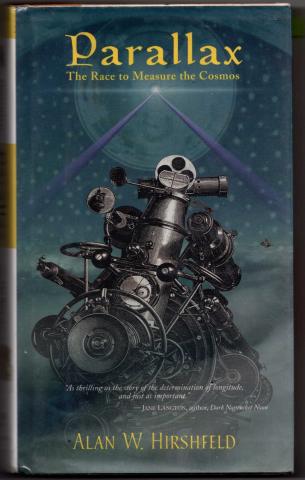- This topic has 0 replies, 1 voice, and was last updated 4 years, 11 months ago by
 Michael E. Marotta.
Michael E. Marotta.
-
AuthorPosts
-
12 December 2020 at 6:57 pm #574825
 Michael E. MarottaParticipant
Michael E. MarottaParticipantParallax: The Race to Measure the Cosmos by Alan W. Hirshfeld, W. H. Freeman & Co., 2001.
The title of the book could be a metaphor for the history of astronomy. We tend to view the history of astronomy as if through one eye: the arrangement of the universe, from the geocentric to the heliocentric model, to the understanding that our own Milky Way is not the universe, but just one of billions of galaxies. Viewing the history of astronomy through the other narrative eye of discovering the size and scale of the universe reveals the depth of the problem and of the geniuses who attempted to solve it. Hirshfeld traverses the history of astronomy by following the track of parallax. The writing is direct, intended for the interested and educated general reader.

If the Earth orbits the Sun, then the planets and the nearest stars would seem to shift in position relative to the farthest background. Archimedes tried to measure it. Galileo tried. It was not until 1838-1839 in close succession and working independently that Friedrich Bessel, Thomas Henderson, and Wilhelm Struve were successful.
Of necessity, our macroscopic sense of place paralleled the discovery of the microscopic. The same lenses served both purposes. It is telling that Joseph Fraunhofer’s 1829 heliometer, the most exacting measuring telescope created up to that time, included a microscope for reading its extremely precise scale.
Science is an integration. Internally consistent theories explain observable facts. It is how we know anything. More to the point, facts and theories do not exist in isolation. Seeming contradictions must be resolved or eliminated. That speaks to the problem of parallax. Herschel’s case, in particular, exemplified the exacting standards to which all scientists adhere. It can be hard to know when your very correct theory only awaits the predicted facts and when the discovered facts demand a new theory.
“Photography of the heavens is one area of astronomy in which amateurs have made, and continue to make, significant contributions.” (page 273)
Like Galileo and the savants who followed, Herschel expected that all of the stars are more or less arrayed at random, that the universe is uniform. Thus, stars that appear to be close to each other are not physical companions. This led astronomers to seek pairs of stars, one much brighter than the other in the expectation that the brighter was the nearer of the two and thus a good candidate for measuring parallax. After years of searching with a behemoth reflector, Herschel announced on July 1, 1802, that many double stars are indeed gravitationally locked.
Also integral to the scientific method, established truths are validated by new discoveries. Following the successful measurement of parallax ten new uses were developed for it.
Alan W. Hirshfeld is currently Professor of Physics, and Director of the Observatory at the University of Massachusetts at Dartmouth, and an Associate of the Harvard College Observatory. He serves as the chair of the History of Astronomy Division of the American Astronomical Society.
Attachments:
-
AuthorPosts
- You must be logged in to reply to this topic.
